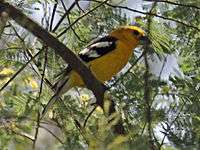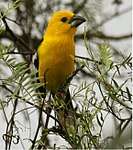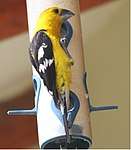Golden grosbeak
| Golden grosbeak | |
|---|---|
_-Ecuador-8.jpg) | |
| Male in Ecuador | |
| Scientific classification | |
| Kingdom: | Animalia |
| Phylum: | Chordata |
| Class: | Aves |
| Order: | Passeriformes |
| Family: | Cardinalidae |
| Genus: | Pheucticus |
| Species: | †P. chrysogaster |
| Binomial name | |
| Pheucticus chrysogaster Lesson, 1832 | |
The golden grosbeak (Pheucticus chrysogaster), also known as golden-bellied grosbeak or southern yellow grosbeak, is a species of grosbeak in the Cardinalidae family. It is very similar to, and has sometimes been considered conspecific with, the yellow grosbeak.
The golden grosbeak is found in Colombia, Ecuador, Peru, Trinidad and Tobago, and Venezuela. Its natural habitats are subtropical or tropical dry forests, subtropical or tropical moist montane forests, subtropical or tropical dry shrubland, and heavily degraded former forest.
Taxonomy
The golden grosbeak belongs to the taxonomic family Cardinalidae. Other members of this family include Cardinals, buntings, and grosbeaks. The genus Pheuticus contains six extant species. Pheucticus in Greek means shy [2] Pheucticus chrysogaster goes by many different English names. Southern Yellow Grosbeak, Golden-bellied Grosbeak, and Golden Grosbeak are used interchangeably because this species has a history of lumps and splits. More recently, Golden Grosbeak has been used over the other in frequently updated and popular websites like eBird.org and Neotropicalbirds.org. Golden Grosbeak is the recommended common name when referring to Pheucticus chysogaster. The taxonomy of this species can be confusing and shows the importance of scientific names. For example, a few field guides and checklist call Pheucticus chrysogaster by many different names for the same species. Southern Yellow Grosbeak is used in The Birds of Ecuador and Golden-bellied Grosbeak is used by the American Ornithologist Union’s (AOU) checklist and The Birds of Northern South America to name Pheucticus chysogaster. Three currently recognized species Golden/Southern Yellow Grosbeak (P. chrysogaster), Black-thighed Grosbeak (P. tibialis) and Yellow Grosbeak (P. chrysopeplus) used to be considered the same species and went under the name Yellow Grosbeak. Southern Yellow Grosbeak was the common name given to the subspecies of the Yellow Grosbeaks found in the South American Andes of Ecuador, Peru, Venezuela, and Columbia that is now recognized as the separate species Golden/Southern Yellow Grosbeak (Pheucticus chrysogaster). Another species of grosbeak was also split from Yellow Grosbeak the same time as the Golden/ Southern Yellow Grosbeak called the Black-thighed Grosbeak (Pheucticus tibialis) [3] Recent phylogenetics supports the separation of these three species and suggests that the Black-backed Grosbeak (Pheucticus aureiventris) is more closely related with common ancestors more recently in the genus evolutionary history [4]
Description
The length of the body is 21 cm (8.3 in).[5] Males are bright yellow with a black wing and back. They have white spots on their median and greater wing-coverts that wear out over time and older birds appear darker. The bill is large and conical in shape, typical of most species in the family Cardinalidae. The Golden Grosbeak is sexually dimorphic in plumage. The females have brown wings and brown streaks covering the head, flanks, back and rump. The immature of this species look similar to the female in plumage and are often not distinguishable in the field.[6]
Behavior and Ecology
Found up to 3000 meters in elevation in a large diversity of habitats. Occurs in semi-open habitats, edges of the forest, and shrub habitat types.[7] Primarily arboreal birds that are often found alone or in pairs. Voice described as fast caroling that is “rich melodie, liquid and full”.[8] Each individual has a large repertoire of songs. “Call a metallic ‘pink’”.[9]
Status
The status of the golden grosbeak is considered Least Concern by IUCN. Justification for assigning this classification is because their range is large and their overall population size if not declining (>30% decline over ten years or three generations).[10]
Gallery
References
- ↑ BirdLife International (2012). "Pheucticus chrysogaster". IUCN Red List of Threatened Species. Version 2013.2. International Union for Conservation of Nature. Retrieved 26 November 2013.
- ↑ "Black-headed Grosbeak Overview, All About Birds, Cornell Lab of Ornithology". www.allaboutbirds.org.
- ↑ "Golden Grosbeak". Handbook of Birds of the World. Retrieved 24 February 2018.
- ↑ Pulgarín-R, P.C.; Smith, B.T.; Bryson, R.W.; Spellman, G.M. (December 2013). "Multilocus phylogeny and biogeography of the New World Pheucticus grosbeaks (Aves: Cardinalidae)". Mol. Phylogenet. Evol. 69 (3): 12221227–. doi:10.1016/j.ympev.2013.05.022.
- ↑ Ridgley, Robert; Greenfield, Paul (2001). The Birds of Ecuador. Cornell University Press.
- ↑ Restal, Robin; Rodner, Clemencia; Lentino, Miguel (2006). Birds of Northern South America. Yale University Press.
- ↑ "Golden Grosbeak". Neotropical Birds. Cornell Lab of Ornithology. Retrieved 24 February 2018.
- ↑ Restal, Robin; Rodner, Clemencia; Lentino, Miguel (2006). Birds of Northern South America. Yale University Press.
- ↑ Restal, Robin; Rodner, Clemencia; Lentino, Miguel (2006). Birds of Northern South America. Yale University Press.
- ↑ "Pheucticus chrysogaster". IUCN Red List. 2016. doi:10.2305/IUCN.UK.2016-3.RLTS.T22723803A94834217.en.



